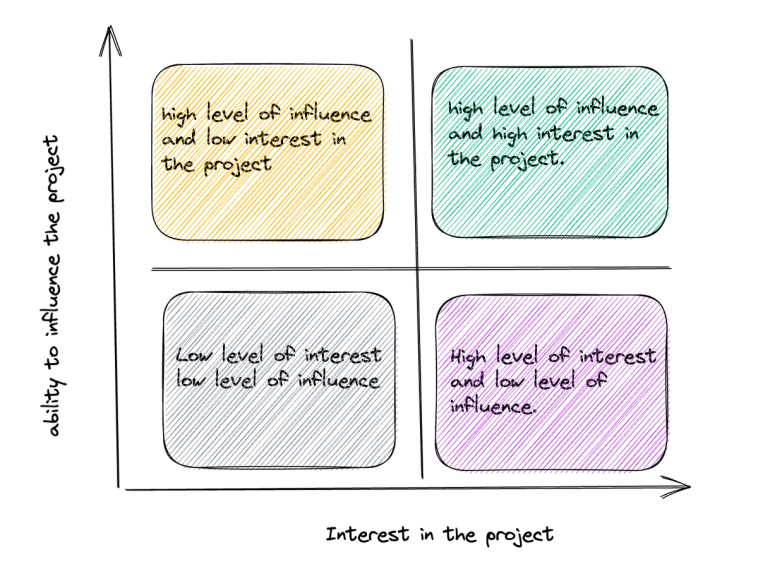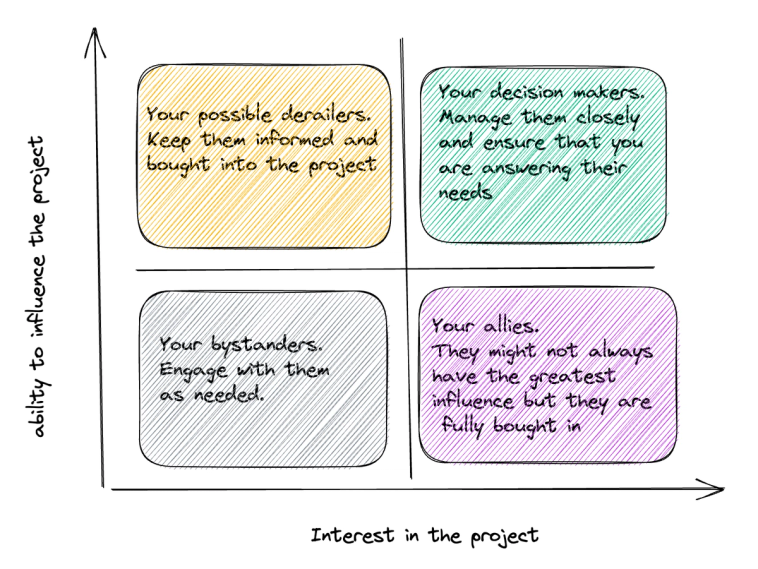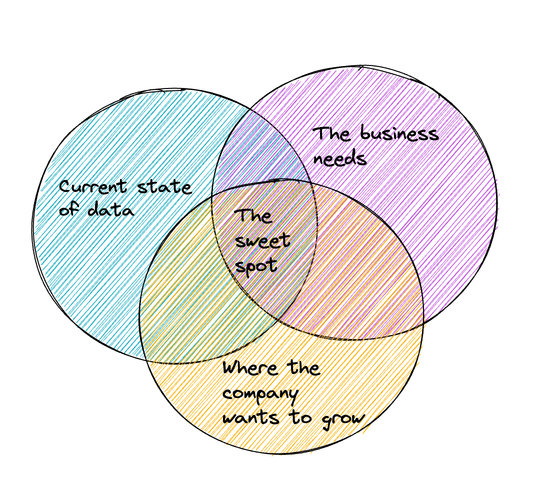The Data Professional’s Cheat Sheet for Working with Stakeholders
Generating impact means convincing the people you work with that the work you do has value for them or their business. Impactis a combination of perception and results.
In this guide, I’ll break down some ways you can manage your stakeholders more effectively on a day-to-day basis, including how to:
- Identify your champions and critics
- Align the business needs with the data priorities
- Understand the problem before you try to solve it
- Build tools to help you prioritize urgent requests
- Master saying no
- Earn trust through hard work and reps
Use the following guide to manage your stakeholders successfully on a day-to-day basis.
Identify your champions and critics
Knowing who you're working with and who calls the shots on a project helps you focus on the right people when making decisions. It also helps you understand how insights drive action and make the most out of your work.
Do you know who your stakeholders are? Do you know who are the decision-makers, troublemakers, allies, and derailers? For every project, you should determine four things:
- Who it impacts the most
- Who the decision-makers are
- Who can influence the project
- Who can derail the project
Stakeholder mapping is a helpful method used to identify important stakeholders. It involves recognizing the people who hold significant influence and interest in a project. This knowledge allows you to customize your work and communication approach to those who can make a difference and can benefit the most from your efforts.
Example of mapping your stakeholders in a grid:

Example of how to use a stakeholder map:

Align the business needs with the data priorities
Take the time to learn about the business or team you work with most closely and identify areas of opportunity for data that match their objectives. To achieve this, develop a data strategy that advances the data maturity of your company and prioritizes projects that will generate the greatest business impact.

To identify opportunities, you need to learn about the business and team functions. This requires some research on the business and how your stakeholders make decisions. You can adopt different approaches based on your learning style:
- : Shadow team members or replicate a workflow that generates data to inform the business.
- : Go on a listening tour or review standard operating procedures.
- : Dive deep into existing documentation, data, and archived resources to gather insights and familiarize yourself with the current landscape.
Use these approaches to gather information, find data-driven solutions, and prioritize projects that improve data literacy and efficiency across the business while meeting its needs. Regardless of the approach you choose, understanding the business priorities is essential.
Understand the problem before you try to solve it
Data professionals often rush to solve problems without fully understanding them. It's important to take a step back and make sure you grasp the problem before diving in. Otherwise, you might end up working on the wrong things and providing insights that don't lead to action. We often assume we all share the same understanding, but stakeholders' wants may differ from what they truly need to solve the problem.
To start, make sure you’re asking the right questions to uncover the root of their problems and needs, such as:
- Why is this project or problem important?
- What action, decision, or next steps will come from the work?
- When does it need to be completed?
- How would they like to review the results?
- Who are the primary consumers?
A good rule of thumb is to summarize your understanding of the problem and see if it aligns with what the stakeholder has asked of you.
While it would be ideal to have answers to all of these questions, it is not always feasible. Your goal should be to tackle each one by the end of the project, or at the very least, document why certain answers couldn't be obtained. This approach will give you valuable insights into the blockers and what types of processes could be put in place to make it easier to get this information.
Build tools to help you prioritize urgent requests
Often, every team lists their requests as urgent (because, within the scope of their work alone, it is). It’s your job to take the full queue of requests and map out which requests are truly urgent, and which can wait.
When you are faced with a long to-do list, you can start to stack rank them in order of urgency by thinking of the following:
- Those that most closely align with company-level focus areas should be a top priority.
- By maintaining an open conversation about capacity and resource availability, you can better manage expectations on what work is feasible at a given time.
- Facilitating cross-team collaboration can help solve multiple questions with one approach.
When you have a clear process for triaging requests and communicating how they’re prioritized, you can make sure the highest-impact projects are done first and stakeholders awaiting work understand where (and why) their requests are in the queue.
Additionally, you should also prioritize knowledge sharing by creating opportunities for non-data team members to learn about the tools and data available to them, enabling them to answer more questions on their own.
Saying no is an art worth mastering
One of the most important skills in managing stakeholders is learning to say no, and being able to back up why. This requires doing your homework and clearly articulating your reasoning.
There are many ways to say no, depending on your framing and the reasons behind why you're pushing back, pausing, rerouting, or reframing something. And, no matter how good your reasoning is, there’s no guarantee that your no will be heard. However, crossing your Ts and dotting your Is ensures you’re on record stating your opinion.
Additionally, as is the case with all feedback, you’ll want to say no in a way that feels authentic (and get some practice in). Here are some tips:
- Identify your communication style
- Have a thought partner that can help you frame your message
- Know your audience
- Articulate your message clearly and prepare for questions
Now that you have some tips on how to go about saying no to certain requests practice this skill in low-stakes situations. As you practice saying no you will notice that it is closely tied to asking the right questions of your stakeholders and identifying the priorities that generate the most value.
Trust is earned through hard work and reps
Trust is the most important currency in stakeholder management and often takes time to build but can be lost in a minute. Building trust with your stakeholders means putting aside all assumptions and taking the time to understand them as people, teams, and companies.
There is no one-size-fits-all approach, but some general guidelines can help you build trust:
- Your stakeholders should feel like you are working hard to make their lives easier.
- Your stakeholders will better be able to adjust their expectations and trust your ability to deliver on your word.
- No topic is too complicated. If you can’t explain something in simple terms, you need to grow your knowledge of it and practice simplifying it. Think of how you would explain it to your mom.
- Share updates, share blockers, ask questions, and engage with your stakeholders. When it feels like you are providing too many updates you are probably providing just enough.
Establish systems and processes to ensure consistent communication with your stakeholders. Building trust requires maintaining clear lines of communication in a deliberate and consistent manner. Include a mix of formal and informal communication channels. Use formal channels like project management tools, shared roadmaps, and project update meetings for outlining action items, addressing questions, and discussing obstacles. Complement these approaches with informal communication channels like Slack updates, chats, and ad hoc meetings to foster open and flexible discussions.
Here’s a not-so-secret-secret: Data isn’t really about data. It’s about helping people.
The more you can hone your ability to understand how your data projects will directly relate to the problems and frustrations of the people consuming it, the greater an asset you are as a data professional.
To recap, here are the key takeaways in building your stakeholder management skills:
- How a project impacts your stakeholders
- Who the decision-makers are
- Who can influence the project
- Who can derail the project
2. Align the needs of the business with the data team priorities
3. Ask the right questions to determine the underlying needs, including:
- Why a project or problem is important
- What action, decision, or next steps will come from the work
- When a project needs to be completed by
- How your stakeholders would like to review the results
- Who the primary consumers will be
4. Have clear goals and objectives
5. Create shared roadmaps
6. Prioritize knowledge sharing through teaching and documentation
7. Facilitate cross-team collaboration
8. Learn to clearly say no to certain requests
9. Build trust through clear and consistent communication and thought partnership
These are only a few approaches to stakeholder management and I would love to hear your own experiences and tools for having a positive and impactful relationship with stakeholders.